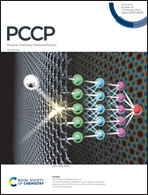Magnetism modulation and conductance quantization in a gadolinium oxide memristor†
Abstract
The requests for higher information storage density, greater data processing power, and memory-centric computing capability in the current big data era are motivating global research interests in novel solid-state electronic devices that can unite the electron charge and spin degrees of freedom. Herein, the simultaneous realization of magnetism modulation and conductance quantization in a single gadolinium oxide memristor is reported. A remarkable enhancement of >170% in saturation magnetization at room temperature, accompanied by the emergence of a clear magnetoresistance behavior at low temperature, was obtained after setting the memristor from the initial high resistance state (HRS) into the low resistance state (LRS). By carefully resetting the memristor from the LRS into the HRS, up to 32 quantized conductance states with good repeatability and stability were observed, which could possibly allow achieving 5 bit storage in a single memory cell in the future. Moreover, the resistive switching mechanism of the memristor was thoroughly investigated with the help of temperature-dependent resistance tests and high-resolution transmission electron microscopy examination. This work could provide a powerful approach to design future multi-field modulated, high-performance information devices with integrated data storage, sensing, as well as processing functions.



 Please wait while we load your content...
Please wait while we load your content...